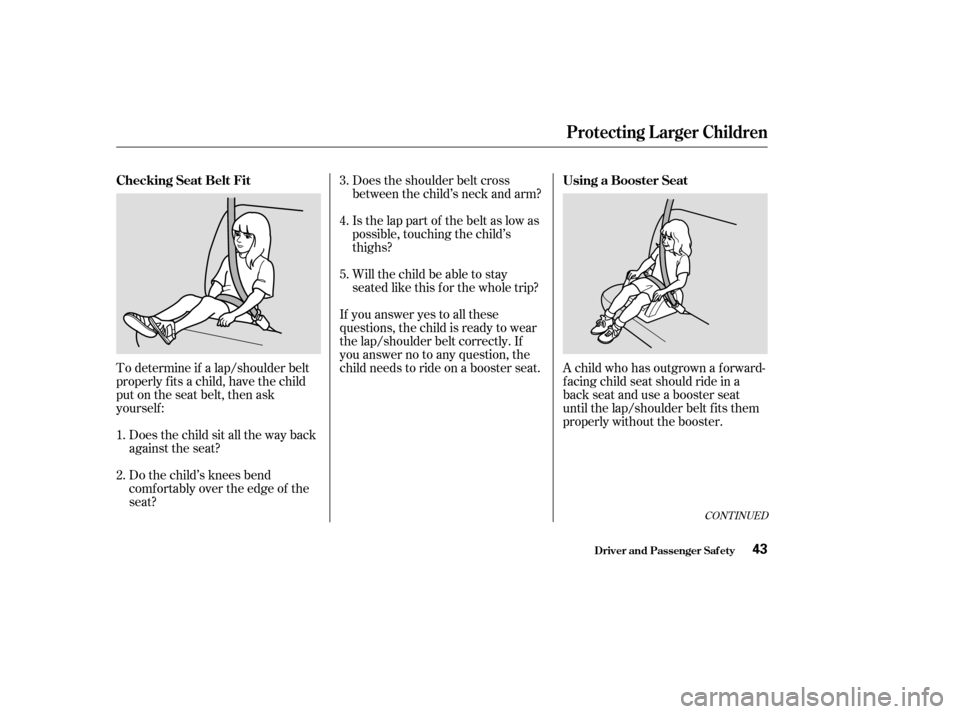Page 42 of 221

To determine if a lap/shoulder belt
properly f its a child, have the child
put on the seat belt, then ask
yourself :Does the child sit all the way back
against the seat?
Do the child’s knees bend
comf ortably over the edge of the
seat? Does the shoulder belt cross
between the child’s neck and arm?
Is the lap part of the belt as low as
possible, touching the child’s
thighs?
Will the child be able to stay
seated like this f or the whole trip?
If you answer yes to all these
questions, the child is ready to wear
the lap/shoulder belt correctly. If
you answer no to any question, the
child needs to ride on a booster seat. A child who has outgrown a f orward- f acing child seat should ride in a
back seat and use a booster seat
until the lap/shoulder belt f its them
properly without the booster.
1. 2. 3.4. 5.
CONT INUED
Protecting L arger Children
Driver and Passenger Saf ety
Checking Seat Belt Fit
Using a Booster Seat
43
�����—�����—�����y�
����
��������y���
�(�����������y���������y
Page 43 of 221

Some states also require children to
use a booster until they reach a
given age or weight (e.g., 6 years or
60lbs).Besuretocheckcurrent
laws in the state or states where you
intend to drive.
Booster seats can be high-back or
low-back. Whichever style you select,
make sure the booster meets f ederal
saf ety standards and that you f ollow
the booster seat maker’s instructions.The National Highway Traffic Safety
Administration and Transport
Canada recommend that all children
age 12 and under be properly
restrained in the back seat.
If the passenger’s f ront airbag
inf lates, and it inf lates in a moderate
to severe f rontal collision, the airbag
can cause serious injuries to a child
who is unrestrained, improperly
restrained, sitting too close to the
airbag, or out of position.
The side airbag also poses risks. If
any part of a larger child’s body is in
the path of a deploying side airbag,
the child could receive possibly
serious injuries.
A child may continue using a booster
seat until the tops of their ears are
even with the top of the vehicle’s or
booster’s seat-back. A child of this
height should be tall enough to use
the lap/shoulder belt without a
booster.
If a child who uses a booster must be
in f ront, move the vehicle seat as f ar
back as possible and be sure the
child is wearing the seat belt
properly.
Protecting L arger Children
Driver and Passenger Saf ety
When Can a Larger Child Sit in Front
44
�����—�����—�����y�
����
����
���y���
�(�����������y���������y
Page 44 of 221

If you decide that a child can saf ely
ride up f ront, be sure to:Caref ully read the owner’s manual
and make sure you understand all
seat belt instructions and all saf ety
inf ormation.
Move the vehicle seat to the rear-
most position.
Have the child sit up straight, back
against the seat, and feet on or
near the f loor.
Check that the child’s seat belt is
properly and securely positioned
and secured. This could result in
serious neck injuries during a crash.
This could cause
very serious injuries during a crash.
It also increases the chance that the
child will slide under the belt in a
crash and be injured.
If they do, they could
be very seriously injured in a crash.
Devices intended to improve a
child’s comf ort or reposition the
shoulder part of a seat belt can make
the belt less ef f ective, and increase
the chance of serious injury in a
crash.
Supervise the child. Even mature
children sometimes need to be
reminded to f asten the seat belts
or sit properly.
Of course, children vary widely. And
while age may be one indicator of
when a child can saf ely ride in the
f ront. There are other important
f actors you should consider.
To saf ely ride in f ront, a child must
be able to f ollow the rules, including
sitting properly, and wearing the seat
belt properly throughout ride.
Physically, a child must be large
enough f or the lap/shoulder belt to
properly f it (see page ). If the seat
belt does not f it properly, with or
without the child sitting on a booster,
the child should not sit in the f ront.
43
Protecting L arger Children
Driver and Passenger Saf ety
Additional Saf ety Precautions
Do not let a child wear a seat belt
across t he neck.
Do not let a child put the shoulderpart of a seat belt behind t he back orunder t he arm.
T wo children should never use t hesame seat belt .
Do not put any accessories on a seatbelt.
Maturity
Physical Size
45
�����—�����—�����y�
����
��������y���
�(�����������y���������y
Page 50 of 221
The U.S. instrument panel is shown. Dif f erences f or the Canadian models are noted in thetext.
Instrument Panel
Inst rument s and Cont rols
L X, U.S. EX, and Canadian Si models
51
MALFUNCTION INDICATOR LAMP
SHIFT LEVER POSITION INDICATORANTI-LOCK BRAKE
SYSTEM INDICATOR
PARKING BRAKE AND
BRAKE SYSTEM
INDICATOR
TRUNK-OPEN INDICATOR
MAINTENANCE
REQUIRED INDICATOR
LOW FUEL INDICATOR
IMMOBILIZER SYSTEM
INDICATOR
SUPPLEMENTAL RESTRAINT
SYSTEM INDICATOR
LOW OIL PRESSURE
INDICATOR HIGH BEAM INDICATOR
SEAT BELT REMINDER LIGHT
CRUISE CONTROL INDICATOR
SIDE AIRBAG CUTOFF INDICATOR
CHARGING SYSTEM
INDICATOR
(P. 55)
(P. 56)
(P. 56)
(P. 55, 182)
(P. 55, 182) (P. 183) (P. 128) (P. 54) (P. 57)
(P. 54) (P. 54)
(P. 55)
(P. 56)
(P. 58)
(P. 56)
�����—�����—�����y�
�������������y���
�(�����������y���������y
Page 51 of 221
Instrument Panel
Inst rument s and Cont rols
Canadian DX model
52
LOW OIL PRESSURE
INDICATORDAYTIME RUNNING
LIGHTS INDICATOR
MALFUNCTION INDICATOR LAMP HIGH BEAM INDICATOR WASHER LEVEL
INDICATOR
TRUNK-OPEN INDICATOR
SIDE AIRBAG CUTOFF INDICATOR
IMMOBILIZER SYSTEM
INDICATOR
CHARGING SYSTEM
INDICATOR SEAT BELT
REMINDER LIGHTMAINTENANCE REQUIRED
INDICATOR PARKING BRAKE AND
BRAKE SYSTEM
INDICATOR
LOW FUEL INDICATOR
SUPPLEMENTAL RESTRAINT SYSTEM INDICATOR
(P. 54)
(P. 57)
(P. 55, 182)
(P. 55, 182) (P. 183) (P. 56)
(P. 54)
(P. 57)
(P. 56)
(P. 56)
(P. 55)
(P. 54) (P. 56)
(P. 58)
�����—�����—�����y�
�������������y���
�(�����������y���������y
Page 52 of 221
Instrument Panel
Inst rument s and Cont rols
U.S. DX model
53
SUPPLEMENTAL RESTRAINT SYSTEM INDICATOR
LOW OIL PRESSURE
INDICATOR MALFUNCTION INDICATOR LAMP HIGH BEAM INDICATORSIDE AIRBAG CUTOFF INDICATOR
TRUNK-OPEN INDICATOR
CHARGING SYSTEM
INDICATOR SEAT BELT
REMINDER LIGHTMAINTENANCE REQUIRED
INDICATOR PARKING BRAKE AND
BRAKE SYSTEM
INDICATOR
IMMOBILIZER SYSTEM
INDICATOR
LOW FUEL INDICATOR
(P. 54)
(P. 57)
(P. 55, 182)
(P. 55, 182)
(P. 183) (P. 56)
(P. 54)
(P. 56)
(P. 55)
(P. 58)
(P. 56)
(P. 54)
�����—�����—�����y�
�������������y���
�(�����������y���������y
Page 53 of 221

Only on models equipped with sideairbags
The instrument panel has many
indicators to give you important
inf ormation about your vehicle. This light comes on when you turn the ignition switch to ON (II). If it
comes on at any other time, it
indicates a potential problem with
your f ront airbags or automatic seat
belt tensioners. On models equipped
with side airbags, this indicator will
also alert you to a potential problem
with your side airbags or passenger’s
side airbag automatic cutoff system.
For complete inf ormation, see page. This indicator comes on when you
turn the ignition switch to ON (II). If
it comes on at any other time, it
indicates that the passenger’s side
airbag has automatically shut off.
For complete inf ormation, see page
.
The seat belt system includes an
indicator on the instrument panel
and a beeper to remind you and your
passengers to f asten your seat belts.
If you turn the ignition switch to ON
(II) bef ore f astening your seat belt,
the beeper sounds and the indicator
f lashes. If you do not f asten your
seat belt bef ore the beeper stops, the
indicator stops f lashing but remainson.
If you continue driving without
f astening your seat belt, the beeper
sounds and the indicator f lashes
again at regular intervals. 27
26
Instrument Panel L ights
Seat Belt Reminder L ight Supplemental Restraint
System Indicator
Side A irbag Cutof f
Indicator
Inst rument s and Cont rols54
�����—�����—�����y�
�������������y���
�(�����������y���������y
Page 75 of 221
When storing cargo, you can move
therearcentershoulderbeltoutof
the way by removing the belt f rom
the guide.
The left and right halves can be
f olded separately f rom inside the
vehicle or inside the trunk. To f old
down the seat-back f rom inside the
vehicle, insert the master key in the
lock on the rear shelf . To f old down
the driver’s side, turn the key
clockwise, pull down the top of the
seat-back, then release the key. To
f old down the passenger’s side, turn
the key counter clockwise and
perf orm the same procedure.
The lid of the console compartment
canbeusedasanarmrest.
Make sure the passenger’s hands or
fingersareawayfromthearmrest
bef ore pushing it down.
It is optional on other models.
Standard on LX and EX models in the
U.S., and DX-G, LX and Si models in
Canada
Seats
Inst rument s and Cont rols
Armrest Folding Rear Seat
76
MASTER KEY GUIDE
CENTER SHOULDER BELT
�����—�����—�����y�
�������������y���
�(�����������y���������y